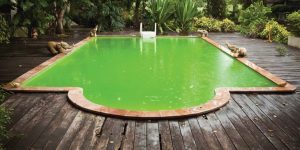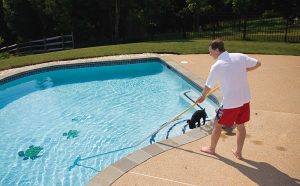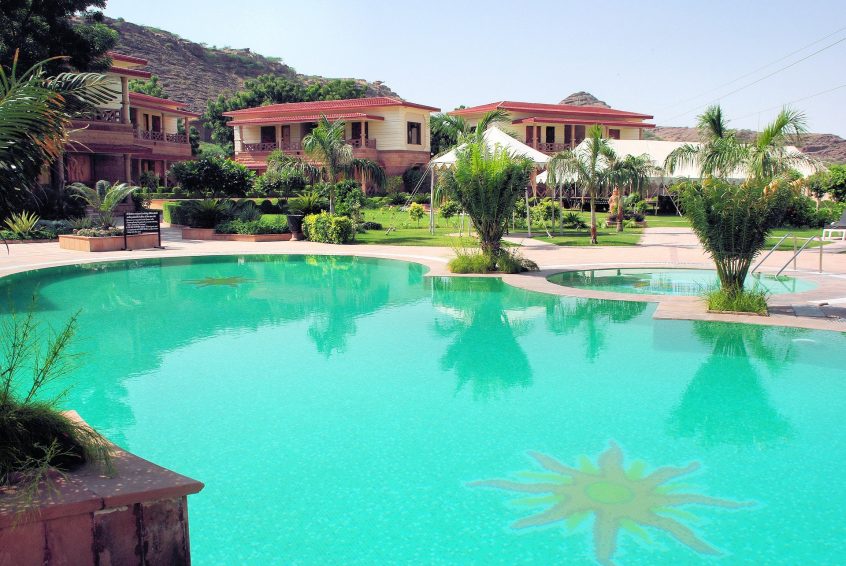Improving water quality demands a true understanding of what is hidden in the pool and spa environment, of what is lurking beneath the surface—in piping, filters and on exteriors.
For decades, pool professionals have faced a particularly tricky phenomenon, one that has created havoc since the first swimming pools and spas. It is that slimy, sticky, gooey stuff that appears along the tile line, around air jets, on ladders and in the filters, pipes and skimmer baskets found in all pools and spas. For many years, pool professionals assumed this troublesome substance was just residual suntan lotion or body oils. Scientists concerned with problematic environments have another name for it—biofilm.
For the past 20 years, recreational water researchers have been focused on understanding the science behind the troubling affect biofilm has on swimming pool and spa water. The conclusion is that trapped within the slime are disease-causing micro-organisms like algae, bacteria and fungi. The U.S. Centers for Disease Control and Prevention (CDC) estimates 65 per cent of human bacterial infections in aquatic environments involve biofilms.
What is biofilm?

Researchers have long been focused on understanding the science behind the troubling affect biofilm has on swimming pool and spa water.
Biofilm, in short, is a collection of microbes living together on a wet surface; it comprises extracellular polysaccharide substance (EPS), which is the slimy goo that encases the organisms and anchors them to a surface. Where there is a wet surface, there is biofilm. Most bacteria grow in biofilms attached to a surface. This is actually experienced in all aspects of living. Plaque buildup on teeth is a prime example; fixtures such as toilets and bathroom basins can also be subject to biofilm contamination. Even leaving an open bottle of water will create biofilm, trapping undetected bacteria beneath its surface.
Pools and spas are an excellent medium for microbes; the wet, warm and nutrient-enriched waters encourage growth. Biofilms harbour algae and water mould as well as recreational water illnesses (RWIs) such as Cryptosporidium,Giardia and E. coli. For example, many spa bathers have experienced the wicked Pseudomonas aeruginosa, commonly referred to as ‘hot tub rash.’ Microbes rapidly re-colonize even within the most well maintained spa environments, allow the bacteria to grow in warm water and shows up as small, itchy red bumps. This annoying skin eruption is a direct cause of biofilm.
Take also the example of black, yellow and green algae, which are microscopic forms of plant life that can be free-floating or attached to a surface. Black algae, the slowest growing of the three varieties, are very resistant to chemicals and can embed itself into the plaster surfaces of a pool or spa. The green algae are free-floating and grow very fast, but are easily controlled with sanitizers and algaecides. Yellow, or mustard algae, appears on walls, mainly in the shade. When the algae is surface-borne, it is much harder to kill. Operators who have examined black algae confirm there is a crusty film or gelatinous sheath over the black algae spore—this is actually a biofilm.
Water mould, on the other hand, has a different structure. It may be called white or pink algae; it may appear to be white, gray or even a tissue paper-like substance. All of these algae are attached to the walls through the biofilm process and can require excessive labour to kill if a preventative maintenance program is not adopted.
Combating biofilm
Fighting biofilm requires an understanding of what it actually is and how to treat it. The need to combat biofilm in the pool and spa environment is vital, as it has a direct influence on chlorine demand; the more biofilm present, the higher the required dosage of chlorine will be. Conversely, as the biofilm diminishes, less chlorine is used.
Unfortunately, conventional methods of microbial control (such as chlorine compounds) have proven inadequate with biofilm. Since it is much harder to kill these organisms once they are established, a constant, preventative maintenance program is the best way to combat biofilm growth.
Sanitizer residual
First and foremost, maintain a sanitizer residual in the pool or spa at all times. The ideal range for chlorine disinfection is three to five parts per million (ppm). Pool and spa operators should pay close attention to sustaining this residual, either through manual testing and/or automatic chemical feed control systems, with constant monitoring.

Daily brushing must be performed on pool and spa tiles, walls and floors, as biofilm tends to attach easily to these sites.
While the sanitizer residual must be constant in all parts of the pool, close attention should be paid to coves and dead zones. In addition, daily brushing must be performed on the tiles, walls and floor, as biofilm tends to attach to these sites (particularly to walls). By brushing these surfaces, the biofilm, containing algae spores, will detach and be released into the water, where it can be more easily killed by disinfectants and algaecides.
Filtration system cleaning
Improving water quality also requires a thorough cleaning of all the filtration systems with an efficient backwashing of sand filters. Degreasing of cartridges and diatomaceous earth (DE) grids must first be performed using tri-sodium phosphate; mere acid washing will not eradicate the biofilm.
As such, chemical cleansing of the filter systems is highly recommended. Dupont’s Roy D. Vore, PhD, a member of the Disinfection and Water Quality task force for the CDC Model Aquatic Health Code (MAHC) suggests, “The use of alkaline cleaners containing either bleach or quats will reduce biofilm; however they do not result in total kill.”
Other treatments
Ozone works effectively to destroy biofilm by rapidly cutting through the gelatinous biofilm bond. Once the biofilm breaks loose, the free-floating bacteria can be trapped in the filtration system or eradicated with chlorine sanitizers.
Additional recommended biofilm control tactics include the addition of surfactants and chelants, weekly shocking with 10 ppm of free available chlorine and use of enzymes (Klueger & Meyer).
Staying ahead of biofilms
Industry professionals are encouraged to learn from the many recent studies being performed by chemical manufacturers. For example, at the 2009 World Aquatic Health Conference (WAHC) in Atlanta, James J. Miller of Micronanosun Technology Group LLC, discussed his study on biofilm and the Legionella phenomenon. His findings included details on how biofilms are established and why they are difficult to control. He also discussed public health implications and concerns and offered some recommendations to the industry.
It is the duty of all pool and spa professionals to maintain safe and healthy swimming venues. Staying up to date on research—and ahead of biofilms—by adding effective, regular maintenance recommendations is the right thing to do, as it will help protect bathers, improve water quality and reduce RWIs.
This article was written by Connie Sue Centrella, and originally appeared on Pool & Spa Marketing [link].
